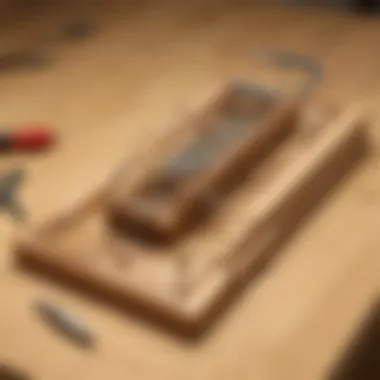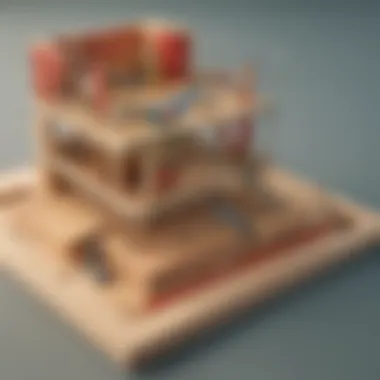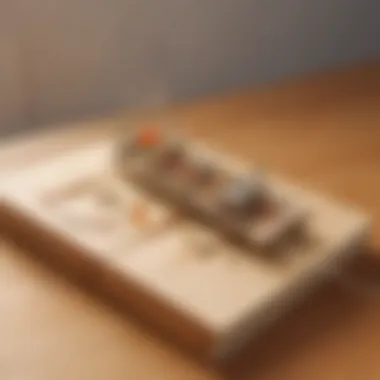Innovative Strategies for Crafting Unique Mouse Traps


Science Fun Facts
Did you know that mice can jump as high as 18 inches and are excellent climbers? Their agility makes designing an effective mouse trap a real challenge!
Discover the Wonders of Science
When delving into building a mouse trap, it's essential to understand the scientific principles behind rodent behavior. Mice have a keen sense of smell and are attracted to certain types of bait like peanut butter and cheese. By utilizing this knowledge, we can develop traps that play on these preferences.
Science Experiment Showcase
Embarking on the journey to construct a mouse trap requires attention to detail and precision. Begin by gathering materials such as wood, metal wire, and a triggering mechanism. Ensure you have protective equipment like gloves and goggles for safety. Next, follow these step-by-step instructions to assemble the trap:
- Cut the wood into appropriate sizes to form the base, walls, and a holding area.
- Attach the metal wire to create a door that can be triggered to close upon capturing a mouse.
- Place the bait inside the trap to entice the mouse.
- Set up the triggering mechanism in a way that releases the door when the mouse enters.
- Monitor the trap regularly to remove any captured mice safely and humanely.
By following these detailed instructions and maintaining safety measures, you can construct a mouse trap that is both effective and humane.
Introduction
In the realm of pest control, the quest for innovation is ceaseless. A critical aspect in this endeavor is the construction of efficient mouse traps. This article delves into the realm of creative strategies and unconventional methodologies to craft bespoke solutions for rodent-related issues. By exploring unique approaches, individuals can transcend the limitations of traditional traps and engineer devices tailored to their specific needs and preferences.
Understanding the Need for Effective Mouse Traps


The presence of mice in human habitats poses not only a nuisance but also significant health risks. Rodents are known carriers of various diseases, making their effective control essential. Understanding the need for efficacious mouse traps is paramount in ensuring the well-being of occupants in a given space. By comprehending the behavior patterns of mice and their affinity for certain environments, individuals can strategically design traps that capitalize on these tendencies, leading to improved trapping outcomes.
Essential Components for a Functional Mouse Trap
In this intricate guide focusing on innovative ways to construct mouse traps, the translation of ingenious concepts into tangible solutions is crucial. Essential components play a pivotal role in the overall efficacy and functionality of the mouse trap design. Without a solid foundation in these components, the traps may not yield the desired results, thus highlighting the critical nature of this topic.
When delving into the realm of essential components for mouse traps, one cannot underestimate the significance of choosing the right materials and considering structural aspects. These components act as the building blocks of an effective trap, dictating its durability, efficiency, and overall success in rodent capture.
In the subsequent discussions, we will dissect the importance of each aspect comprehensively, shedding light on their unique benefits and how they contribute to the holistic effectiveness of the mouse trap design. By focusing on these key elements, individuals can elevate their trap construction prowess and optimize their solutions with precision and innovation.
Choosing the Right Materials
Choosing the appropriate materials for constructing a mouse trap is a fundamental step in ensuring its functionality and durability. The selection of materials should be guided by factors such as durability, effectiveness, and ease of procurement. Opting for robust and long-lasting materials can enhance the trap's longevity and effectiveness in capturing rodents.
Moreover, the choice of materials can impact the environmental sustainability of the trap. Prioritizing eco-friendly options not only aligns with ethical considerations but also promotes responsible pest control practices. By exploring a wide array of material choices and understanding their properties, individuals can tailor their traps to suit their specific needs and values.
Structural Considerations
Structural considerations encompass the design and layout of the mouse trap, influencing its functionality and performance. Factors such as trap size, mechanism efficiency, and placement versatility need to be thoughtfully analyzed to ensure optimal results. A well-thought-out structural design can streamline the trapping process and increase the success rate of capturing rodents.
Additionally, structural robustness is essential to withstand the rigors of repeated use and environmental conditions. By incorporating sturdy and resilient construction practices, individuals can create durable traps that deliver consistent results over time. Embracing innovative structural approaches can revolutionize the efficacy of mouse traps, offering unique solutions to common rodent control challenges.
Innovative Approaches to Mouse Trap Design


In the realm of constructing mouse traps, the emphasis on innovation cannot be overstated. Innovative approaches to mouse trap design play a pivotal role in this article, as they pave the way for novel solutions to rodent issues. By delving into unique and creative methods, individuals can craft mouse traps that not only effectively capture rodents but also introduce cutting-edge functionalities.
Utilizing Technology for Enhanced Efficiency
One of the key aspects under the lens of innovative mouse trap design is the integration of technology for heightened efficiency. Leveraging technological advancements allows for the development of smart traps that can autonomously sense rodent presence and trigger mechanisms accordingly. Sensors, cameras, and smart actuators are some of the components that can be incorporated to enhance the trap's effectiveness and streamline the trapping process.
Implementing Eco-Friendly Solutions
Another critical facet in innovative mouse trap design involves the implementation of eco-friendly solutions. Considering the environmental impact of traditional trapping methods, eco-conscious approaches prioritize the use of sustainable materials and humane trapping techniques. Biodegradable traps, natural attractants, and non-toxic bait options are being explored to create traps that are effective yet eco-sensitive, aligning with contemporary conservation efforts.
Incorporating Unconventional Trap Mechanisms
Diving further into innovation, the incorporation of unconventional trap mechanisms sets a new horizon for mouse trap design. Utilizing out-of-the-box thinking, unconventional traps can range from pneumatic systems to magnetic closures, offering unique ways to capture pests. These mechanisms not only expand the design possibilities but also challenge the conventional norms of trapping, opening doors to inventive solutions unmatched by traditional designs.
Step-by-Step Guide to Building a Custom Mouse Trap
In this pivotal section, we delve into the intricate process of crafting a custom mouse trap. Constructing a mouse trap goes beyond mere functionality; it is about innovation and problem-solving. The significance of a step-by-step guide in building a custom mouse trap lies in its ability to streamline the complex construction process into manageable steps. This section aims to empower readers with the knowledge and skills necessary to create their unique solutions to rodent infestations.
Design Conceptualization and Planning
Design conceptualization and planning are the foundational stages of building a custom mouse trap. Before picking up any tools, thorough planning is essential. Consider the size of the trap, the materials needed, and the trap's mechanism. A well-thought-out design will ensure the trap is effective in capturing mice while also being safe for children and pets. Take time to sketch your design, incorporating innovative ideas that set your trap apart.


Construction Process Details
The construction phase is where your vision starts to take shape. Choosing the right materials is crucial - opt for durable, non-toxic substances that will withstand wear and tear. Pay close attention to the assembly process, ensuring all components fit together seamlessly. Precision is key during construction to prevent any gaps or malfunctioning parts. Each step should be executed with care, following the design plan meticulously to bring your custom mouse trap to life.
Testing and Refinement
Once your mouse trap is built, testing its functionality is paramount. Place bait inside and observe how the trap operates. Make necessary adjustments to improve its efficiency if needed. Refinement is an ongoing process; don't hesitate to modify the design based on testing results. Ensure the trap is humane and swift in capturing mice, maintaining its safety features. Through rigorous testing and refinement, your custom mouse trap can reach its full potential in addressing rodent issues.
Safety Considerations and Best Practices
Safety considerations and best practices are critical aspects when designing and building a mouse trap. In this article, we emphasize the paramount importance of prioritizing safety measures to protect both individuals and animals. Implementing stringent safety protocols not only prevents accidents but also ensures the effective functioning of the mouse trap.
One key element to consider when focusing on safety is the materials used in constructing the mouse trap. Utilizing non-toxic and sturdy materials reduces the risk of harm to children and pets who might come into contact with the trap. Additionally, incorporating safety features such as smooth edges and secure closures further minimizes the chances of accidental injuries.
Another benefit of prioritizing safety considerations is fostering a secure environment within households. By adhering to best practices in mouse trap design, individuals create a safeguarded space that promotes peace of mind for both parents and pet owners. This approach not only enhances the effectiveness of the trap but also formulates a responsible and considerate attitude towards pest control.
Moreover, engaging in ethical trapping methods aligns with legal compliance guidelines and reflects a conscientious approach to handling rodent issues. Ethical trapping emphasizes the humane treatment of pests, advocating for live capture and safe release methods. This ethical framework not only upholds legal standards but also underscores the respect for all living organisms, thereby cultivating a harmonious coexistence between humans and wildlife.
Ensuring Child and Pet Safety
When designing a mouse trap, ensuring the safety of children and pets is paramount. Properly securing the trap and placing it out of reach of curious hands and paws is essential. Additionally, using non-toxic materials and avoiding sharp edges minimize potential hazards in case of accidental contact.
Teaching children about the dangers of mouse traps and establishing clear boundaries regarding handling the traps can prevent accidents. Make sure to involve children in discussions about trap safety and educate them on the importance of keeping away from such devices to avoid any harm.
Legal Compliance and Ethical Trapping
Compliance with legal regulations and ethical trapping practices is essential for maintaining integrity in pest control. Understanding local laws pertaining to trapping and disposing of pests ensures adherence to legal standards. Furthermore, following ethical trapping guidelines, such as using humane methods and releasing captured rodents appropriately, reflects a compassionate approach towards pest management.
Ethical trapping not only ensures the welfare of the targeted pests but also contributes to environmental conservation by promoting sustainable pest control practices. By embracing legal compliance and ethical trapping principles, individuals uphold ethical standards and demonstrate a responsible approach to addressing rodent issues.







